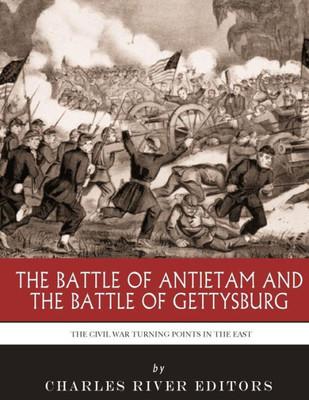*Includes pictures of important people, places, and events. *Includes maps of the battles. *Comprehensively covers the entire Maryland Campaign of 1862 and the Pennsylvania campaign of 1863, as well as the aftermath and legacies of the battles. *Analyzes the generalship of the battles' most important leaders, including Lee, McClellan, Longstreet, Meade, and more. *Includes bibliographies for further reading. "The fact of the matter is that George G. Meade, unexpectedly and against all odds, thoroughly outgeneraled Robert E. Lee at Gettysburg." - Stephen Sears "Those in whose judgment I rely tell me that I fought the battle splendidly and that it was a masterpiece of art. ... I feel I have done all that can be asked in twice saving the country. ... I feel some little pride in having, with a beaten & demoralized army, defeated Lee so utterly." - George McClellan The bloodiest day in American history took place on the 75th anniversary of the signing of the Constitution. On September 17, 1862, Robert E. Lee's Confederate Army of Northern Virginia fought George McClellan's Union Army of the Potomac outside Sharpsburg along Antietam Creek. That day, nearly 25,000 would become casualties, and Lee's army would barely survive fighting the much bigger Northern army. Although the battle was tactically a draw, it resulted in forcing Lee's army out of Maryland and back into Virginia, making it a strategic victory for the North and an opportune time for President Abraham Lincoln to issue the Emancipation Proclamation, freeing all slaves in the rebellious states. Less than a year later, the most famous battle of the Civil War took place outside of the small town of Gettysburg, Pennsylvania, which happened to be a transportation hub, serving as the center of a wheel with several roads leading out to other Pennsylvanian towns. From July 1-3, Robert E. Lee's Confederate Army of Northern Virginia tried everything in its power to decisively defeat George Meade's Union Army of the Potomac, unleashing ferocious assaults that inflicted nearly 50,000 casualties in all. Day 1 of the battle would have been one of the 25 biggest battles of the Civil War itself, and it ended with a tactical Confederate victory. But over the next two days, Lee would try and fail to dislodge the Union army with attacks on both of its flanks during the second day and Pickett's Charge on the third and final day. Meade's stout defense held, barely, repulsing each attempted assault, handing the Union a desperately needed victory that ended up being one of the Civil War's turning points. After the South had lost the war, the importance of Antietam and Gettysburg was apparent to everyone, making the battles all the more important in the years after it had been fought. While former Confederate generals cast about for scapegoats, with various officers pointing fingers at Robert E. Lee, James Longstreet, and James Stuart, historians and avid Civil War fans became obsessed with studying and analyzing all the command decisions and army movements during the campaigns. Despite the saturation of coverage, millions of Americans continue visiting the two battlefields. The Civil War Turning Points in the East comprehensively covers the two crucial campaigns, analyzing Lee's invasion strategies, the Union's response, and the generalship of the most important commanders of the battles. Along with bibliographies, maps of the battle, and pictures of important people and places, you will learn about the Antietam and Gettysburg like you never have before.
- | Author: Charles River Charles River Editors
- | Publisher: Createspace Independent Publishing Platform
- | Publication Date: Feb 05, 2018
- | Number of Pages: 238 pages
- | Language: English
- | Binding: Paperback
- | ISBN-10: 1985029464
- | ISBN-13: 9781985029460




